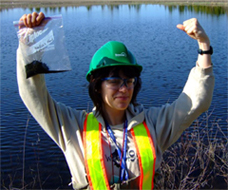Rebecca Rooney, Research Associate
 |
Rebecca Rooney, Research Associate
CW 315 Biological Sciences Bldg.
University of Alberta
Edmonton, AB T6G 2E9
Email: rrooney@ualberta.ca
Tel: (780) 492-4615
Alberta Oil Sands:
Extracting bitumen from the Athabasca oil sands deposit by open pit mining affects vast tracts of land. As of 2009, 67330 ha of boreal Alberta were disturbed by mining and associated activities such as tailings storage. Before mining commenced, over 50% of this land was consisted of peat accumulating wetlands, predominantly forested fens. The Environmental Protection and Enhancement Act of Alberta stipulates that the post-mining landscape must possess "equivalent land capability" to the pre-mining landscape, dictating that companies must re-establish wetlands as part of their reclamation plan.
Unfortunately, reclamation has lagged far behind development. After more than 30 years of reclamation work, only 104 ha of land has been certified as reclaimed by the province. Certification requires an evaluation to determine whether the companies have met their approved reclamation goals and legal obligations. Based on new recommendations from the Cumulative Effects Management Association, the reclaimed land should be self sustaining, comprised of locally common land features, support natural functions, and possess an end land use capability equivalent to that prior to disturbance (CEMA 2009). The evaluation of whether a parcel of reclaimed land meets these criteria must be both legally and scientifically defensible.
Development of an oil sands wetland reclamation evaluation tool is urgently needed. Firstly, although industry reports that 5609 ha of land have been reclaimed, only 104 ha have been assessed for certification and this did not include any wetland habitat. Thus, industry continues to carry the reclamation liability. Secondly, without a method for evaluating the success of past reclamation projects we cannot learn from them or employ an adaptive management strategy. Thirdly, expansions and new developments in the Athabasca oil sands region are being approved at an unprecedented pace and scale. Approvals are issued on the premise that reclamation of wetlands in the region is possible; however, without an evaluation tool, it remains unproven that restoring the functionality of wetlands in the region is technically and scientifically feasible. Such proof is necessary to justify the continued approvals of oil sands exploitation projects in the region.
Ph.D. Thesis:
I am nearing the completing of my PhD. thesis research, which focused on developing biological assessment tools to be used in monitoring and evaluation of wetland reclamation success in the Alberta oil sands region. I focused on shallow open-water marsh systems across a gradient in salinity, with particular interest in aquatic plant communities. I compared relatively undisturbed reference wetlands to constructed ones in terms of their physical and chemical condition to develop an abiotic stress gradient. I then used this stress gradient to build an index of biological integrity (IBI) to evaluate constructed wetlands based on their plant communities. I also modeled the effects of local- and landscape-level habitat variables in determining aquatic plant diversity using structural equation modeling (SEM). This work was in collaboration with my thesis advisor Dr. Suzanne Bayley and MSc. student Dustin Raab at the University of Alberta.
Upcoming:
I am now beginning to look at wetlands in the Aspen Parkland habitat of central Alberta. My next project will involve exploring differences in the community composition of aquatic plants, invertebrates, waterfowl and wetland dependent song birds in natural and constructed wetlands around Edmonton. I will evaluate the concordance among these four commonly sampled taxa and will test whether their community composition is related to surrounding land use at a variety of spatial scales. This work is in collaboration with my thesis advisor Dr. Suzanne Bayley, as well as Dr. Lee Foote, and MSc. student Matt Wilson from the University of Alberta and Dr. Irena Creed from the University of Western Ontario.
Publications:
Rooney, R. C. and S. E. Bayley. 2011. Development and testing of an index of biological integrity based on submersed and floating vegetation and its application to assess reclamation wetlands in Alberta's oil sands area, Canada. Environmental Monitoring and Assessment. DOI: 10.1007/s10661-011-1999-5
Rooney, R. C. and S. E. Bayley. 2011. Setting appropriate reclamation targets and evaluating success: aquatic vegetation in natural and post-oil-sands mining wetlands in Alberta, Canada. Ecological Engineering 37: 569-579.
Rooney, R. C. and S. E. Bayley. 2010. Quantifying a stress gradient: an objective approach to variable selection, standardization and weighting in ecosystem assessment. Ecological Indicators 10: 1174-1183.
Rooney, R. C. and C. L. Podemski. 2010. Freshwater rainbow trout (Oncorhynchus mykiss) farming affects sediment and pore-water chemistry. Marine and Freshwater Research 61: 513-526.
Rooney, R. C. and C. L. Podemski. 2009. Effects of an experimental rainbow trout (Oncorhynchus mykiss) farm on invertebrate community composition. Canadian Journal of Fisheries and Aquatic Sciences 66: 1949-1964.
Rooney, R. C. and M. J. Paterson. 2009. Ecosystem effects of rainbow smelt (Osmerus mordax) invasions in inland lakes: a literature review. Canadian Technical Report of Fisheries and Aquatic Sciences #2845, Fisheries and Oceans Canada: 33 pp.
|
Last Modified:2011-12-12 |